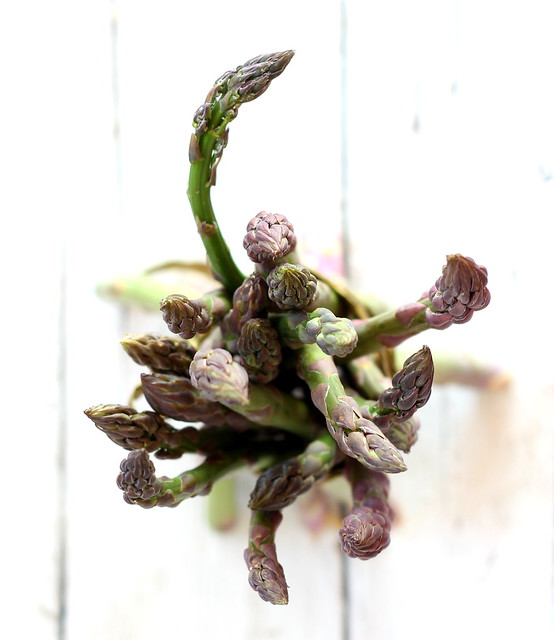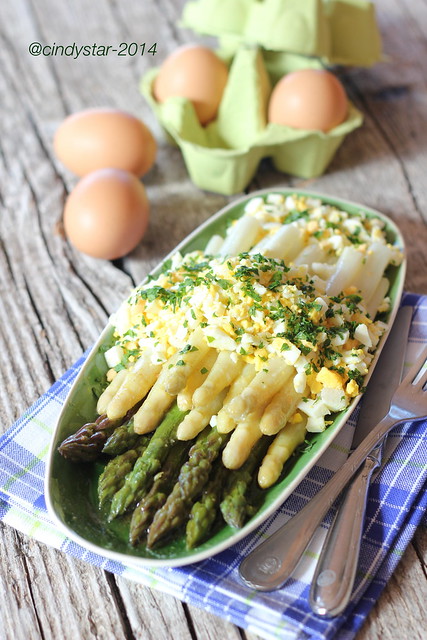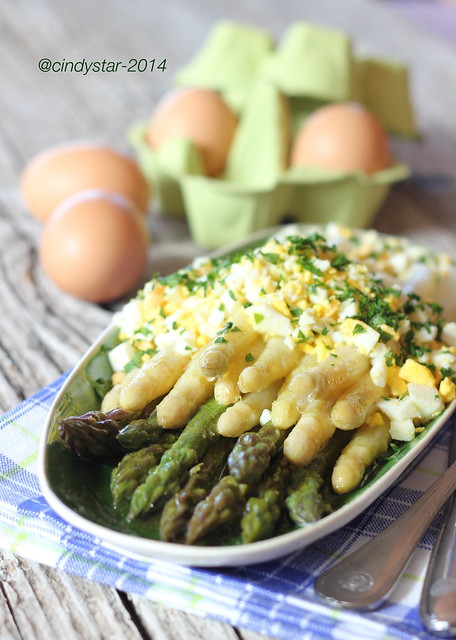Asperges à la flamande - Flemish Asparagus
la ricetta in italiano qui
It’s Spring time, asparagus time, lord of the kitchen and present in almost every seasonal buffet.
They are so good and healthy that is so hard to resist.
They belong to Liliaceae family, along with onion, garlic and leeks.
They are so good and healthy that is so hard to resist.
They belong to Liliaceae family, along with onion, garlic and leeks.
Known since ancient times, as wikipedia shows:
Asparagus was cultivated and used by the Egyptians in the Mediterranean and Asia Minor 2,000 years ago, as well as in Spain. While the Greeks do not seem to cultivate asparagus, the Romans in early 200 BC had manuals set with all details about its cultivation. The asparagus was just mentioned by Theophrastus, Cato, Pliny and Apicius; in particular the latter two described accurately not only the method of cultivation, but also how to use it. Roman emperors liked the asparagus so much, that it is told they had special vessels to go and collect this vegetable, ships named as asparagus. But there was always and only a privilege for the rich gourmets.
From the XV century asparagus began to be cultivated in France, and then, in the sixteenth century, became very popular in England too; only later was introduced in North America. Native Americans used to dry asparagus to use as medicament herb.
Bernard Delcord, columnist of Belgium Delta Guide, tells us the story of Belgian asparagus in this interview:
According to the European Union rules, there are four varieties of asparagus: white, green, purple and green&purple.
They are grown almost exclusively in the Flemish part of the country, especially in Malines e Louvain area.
The Belgian asparagus, and most of all the white ones, have enjoyed a very high reputation in the XVII century until 1960.
Then their cultivation lived a long decline in Flanders, due to many reasons: the reckless taxation that the Government required, considering asparagus a luxury product, cheaper imports mainly from Asia, but also from Greece and Italy, and the great workload that the a high quality production requires.
Farmers have thus preferred to grow cauliflower and chicory, more profitable and less tiring.
Since the late 1980s, as a result of renewed consumer interest in traditional high quality, farmers resumed the production of asparagus in Flanders. But still it can not cope with the demand, so markets give on sale asparagus imported from Spain, Italy, France, Greece and even from the United States, and Belgian asparagus are still very expensive.
Asparagus is not a Belgian native vegetable, some historians believed to see the representation of asparagus on the walls of a pyramid in Saqqara, Egypt, and that would bring its culture more than 5000 years before our era. But on the other hand, some other historians have always declared that they were actually shoots of papyrus.
In any case, you will know for sure that the Greeks used wild asparagus for therapeutic purposes. Hippocrates, for example, has always said that the asparagus root was very effective against dysentery and lumbago. Always the Greeks recognized its aphrodisiac and contraception properties. This is the reason why this plant has been dedicated to Aphrodite, the goddess of love.
It was the Romans who invented the cultivation of asparagus, considered always a luxury product for its particular taste, and for the different properties attributed to it. They used to eat raw asparagus, smoked or cooked.
According to Plutarch, Julius Caesar was a big fan of asparagus and Cleopatra, his famous lover, took advantage of the special aphrodisiac properties.
The Middle Ages was a disastrous period for the cultivation of this vegetable, considered too complicated and uncertain.
During the Renaissance, the Medici brought asparagus to ancient honors, and after them was the king of France, who were fighting in Italy, and Charles V. It was him who brought Flemish Asparagus, less bitter than Spanish ones, to be smart and fashion.
And the popular tradition was born.
In the XIX century the cultivation of asparagus arrived at its peak, with the introduction of modern farming methods, so to offer this good vegetable on the tables of the Belgian bourgeoisie of the time, when the country was among the richest in the world.
Asparagus and boiled eggs, a very popular traditional combination.
Usually seasoned with olive oil and vinegar, but let's indulge some time in the creamy richness of butter, and enjoy the very special asperges à la flamande.
Usually seasoned with olive oil and vinegar, but let's indulge some time in the creamy richness of butter, and enjoy the very special asperges à la flamande.
White or green does not matter, just use your favorite and put in the pan, maybe a lady pan as
WMF Vitalis (a super b'day gift from dear friends) and choose the best butter you can find, salted or unsalted at your pleasure.
You need:
fresh asparagus
eggs
abundant butter
chopped parsley
nutmeg, optional
eggs
abundant butter
chopped parsley
nutmeg, optional
Cut off a quarter of the asparagus and peel them with a potato peeler.
Rinse well in cold water and cook until al dente in the pot or steam. Drain and let cool.
Cook eggs in boiling water 8 minutes, cool under cold running water, peel and chop with a knife or smash with a fork.
Melt the butter in a saucepan and let it get slightly golden.
Arrange the asparagus on a plate, sprinkle with a few tablespoons of melted butter, add the chopped eggs, a couple of tablespoons of melted butter, a sprinkle of nutmeg, if desired, and then parsley. Serve immediately.
If you like, you can prepare a sort of sauce mixing the chopped eggs, melted butter, nutmeg and parsley, then pouring it on asparagus.

















2 commenti:
Amo gli asparagi cosí... Semplici e buonissimi! :) che voglia! :)
Terry, grazie, peccato che durino per un periodo così limitato per cui ... avanti con le scorpacciate! :-)
Posta un commento
grazie della visita e gentilmente firma sempre i tuoi commenti!
thanks for passing by and please sign up your comments!